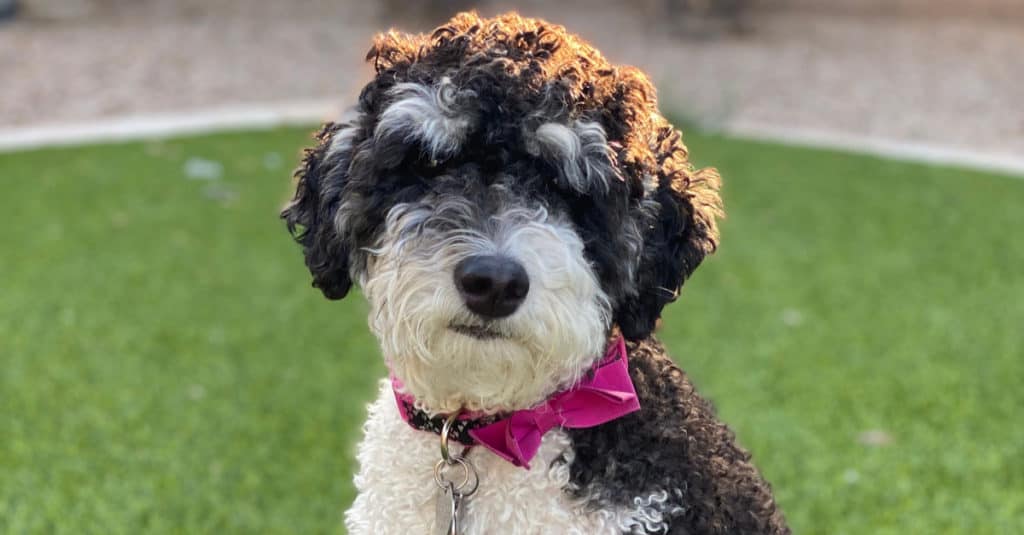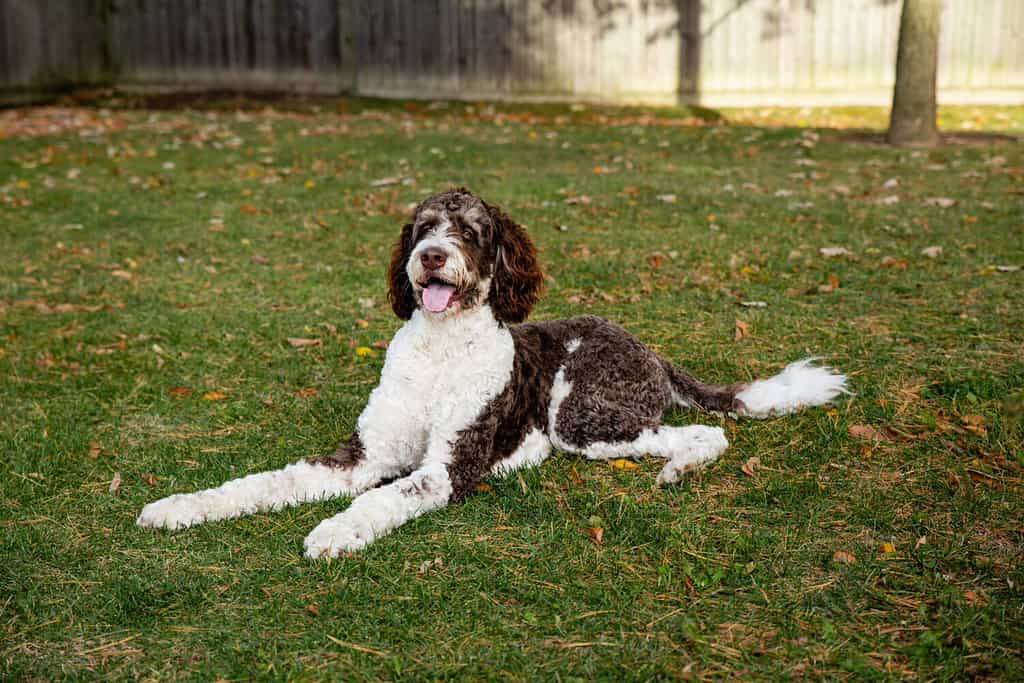Mini Bernedoodles are a mixed breed, so they vary a lot. This breed combines a Bernese Mountain Dog with a Poodle, leading to a smaller dog (though how small is a bit up to debate). Of course, these dogs can still vary quite a bit.
Mini Bernedoodle Summary
As we’ve stated, this mixed breed combines the Bernese Mountain Dog with the Poodle. Usually, these dogs are affectionate and intelligent. They’re wonderful companions in many cases. However, they vary widely, as they are a mixed breed.
Mini Bernedoodle Growth and Weight Chart by Age
| Age | Weight |
|---|---|
| Birth | 8 – 16 ounces |
| 1 Month | 5 – 10 pounds |
| 6 Weeks | 7 – 15 pounds |
| 2 Months | 10 – 20 pounds |
| 3 Months | 15 – 30 pounds |
| 4 Months | 20 – 40 pounds |
| 5 Months | 25 – 50 pounds |
| 6 Months | 30 – 60 pounds |
| 7 Months | 35 – 70 pounds |
| 8 Months | 40 – 80 pounds |
| 9 Months | 45 – 90 pounds |
| 10 Months | 50 – 100 pounds |
| 11 Months | 55 – 110 pounds |
| 12 Months | 60 – 120 pounds |
| 2 Years | 65 – 130 |
When Will My Mini Bernedoodles Stop Growing?
Mini Bernedoodles typically stop growing quite as fast, around 12 months of age. However, the exact timing can vary greatly, as these dogs are a mixed breed. Even after 12 months, though, they will continue to fill out and develop for several more months. Mental and behavioral developments continue well into their second year.
To ensure your Mini Bernedoodle is growing at a healthy rate and to address any concerns, it’s essential to maintain regular check-ups with your veterinarian. Because these dogs can vary heavily, the growth rate can range dramatically without necessarily being negative.
How Big Will My Bernedoodle Be When It’s Fully Grown?
The size of a fully grown Bernedoodle will vary depending on many different factors, including the genetics and the specific generation of Bernedoodle. Here are the general breakdowns:
- Standard Bernedoodle: A standard Bernedoodle, which is usually an F1 (first-generation) cross between a Bernese Mountain Dog and a Standard Poodle, can weigh between 70 to 90 pounds or more and stand around 23 to 29 inches tall at the shoulder.
- Miniature Bernedoodle: A miniature Bernedoodle, often the result of breeding a Bernese Mountain Dog with a Miniature Poodle, typically weighs between 25 to 49 pounds and stands approximately 18 to 22 inches tall at the shoulder.
Of course, dogs fall outside of these size ranges, as they vary a lot. Regular check-ups with your Bernedoodles are important to ensure that your dog is growing properly. It’s especially important for your dog to avoid being overweight.
When Should My Mini Bernedoodle Be Spayed or Neutered?
The timing of spaying or neutering your Mini Bernedoodle can vary. You should consult your vet, as there are pros and cons to both early and delayed spaying and neutering.
There are two main spaying and neutering options: early and delayed.
Early spaying and neutering are typically recommended to prevent accidental pregnancy. During the procedure early can also help prevent certain cancers. However, some vets do recommend delaying the procedure a little bit.
Because these dogs can be larger, the hormones produced by the sex organs may be necessary to help with growth. These dogs can be prone to joint issues like hip dysplasia. Therefore, some vets may highly recommend waiting until the dog is fully grown.
That said, this is an ongoing debate between vets. Therefore, you’ll probably find very different suggestions depending on who you talk to.
When Should My Mini Bernedoodle Be House Broken?
You should start housebreaking your mini bernedoodle as soon as they come to your house. Some breeders may even start housebreaking before they send their puppies to their forever homes.
Establish a consistent schedule for taking your mini benerdoodle outside. More is typically better, but you can lessen the number of trips as your dog figures out the process. Take your bernedoodle out first thing in the morning, after meals, and before bedtime. You should take them outside regularly during the day, too.
Use positive reinforcement, like treats, when your dog goes outside properly. These help them associate going outside with positive feelings, which can encourage them to continue using it outside.
When your dog is inside, keep a close eye on them. If your dog shows signs that they need to go, take them outside right away. You should also take them straight outside if they have an accident.
Be prepared for accidents during the training process. When accidents occur, clean them up thoroughly to remove any lingering odors that might attract your dog to the same spot. Housebreaking takes time and patience, so prepare appropriately.
When Should My Mini Bernedoodle Stop Eating Puppy Food?
You should keep your Mini Bernedoodle on puppy food until they reach their adult size. This food includes extra nutrition to help with their growth. They need these extra vitamins and minerals until they reach their adult weight. Usually, this is between 18 to 24 months, though some may reach it sooner.
When you’re ready to shift their food, gradually transition them. Start by mixing a small amount of adult food with the puppy food, then gradually increase the proportion of adult food over the course of a week or so.
Ensure that you’re transitioning to a high-quality adult dog food formula that meets the needs of your dog. Often, the brand of their puppy food will make adult food, too, and this may be the easiest option to switch to.
As you switch your dog’s food, monitor their health to ensure it is meeting their needs. Some dogs may do fine with a food transition, while others may have a harder time.
When Will My Mini Bernedoodle Start Losing Teeth?
Mini bernedoodles typically start to lose their puppy teeth between 4 to 6 months. This process is similar to that of most dog breeds out there. During teething, these dogs will chew on objects more frequently to relieve discomfort. Provide appropriate chew toys to help alleviate the pain and encourage them to use them.
As the puppy teeth are lost, the adult teeth will start to come in. You may notice that your Mini Bernedoodle has slightly larger teeth at this stage. This process can cause some discomfort, which is why they may continue to chew.
It’s important to supervise your dog during this time, as they may chew on items that they shouldn’t. Start regular brushing during this time if you haven’t already.
When Should I Start Training My Mini Bernedoodle?
You should start training your Mini Bernedoodle as soon as they come home. This is the prime age to start introducing basic training and socialization.
Begin socializing your Mini Bernedoodle with other dogs, people, and various environments as early as possible. Socialization helps them develop into well-adjusted, confident, and friendly dogs. Your primary job is to socialize your canine during this time.
You can start teaching basic commands like “sit,” “stay,” and “come” as early as 8 to 10 weeks. Use positive reinforcement techniques, including treats and praise, to encourage good behavior. It may take them a while for them to learn, but introducing them to training early can be helpful.
Consider enrolling your Mini Bernedoodle in puppy training classes as early as possible. Not only does this help introduce them to training, but it also helps them socialize a bit. Often, your puppy can enroll as soon as they have their first vaccinations.
On top of basic obedience, you should begin house training right away, too. Consistent and positive reinforcement training is essential for successful house training.
Your puppy should also start learning basic manners, such as not biting or jumping. Consistent correction can help your puppy not make these behaviors a habit.
What Cues Should I Teach My Mini Bernedoodle First?
You can start training your dog right away. While there are several ways to begin teaching commands, here is the general order we recommend:
- Sit: Teaching your Mini Bernedoodle to sit on command is one of the most basic and useful cues. It helps with impulse control and can be used in various situations.
- Stay: “Stay” is vital for keeping your dog safe and well-behaved. It’s useful when you need your Mini Bernedoodle to remain in one place until you release them.
- Come: The “come” command is crucial for ensuring your dog returns to you when called. This cue can be a lifesaver in various situations.
- Leave It/Drop It: Teaching your dog to “leave it” or “drop it” is essential for their safety. It helps prevent them from picking up or consuming harmful items.
- Heel: “Heel” is a useful command for walking your dog on a leash without pulling. It encourages them to walk beside you.
- Down: The “down” command instructs your dog to lie down, which is a valuable cue for keeping them calm and well-behaved.
- Quiet: Teaching your Mini Bernedoodle to be quiet on command is important for controlling excessive barking.
When Will My Mini Bernedoodle Calm Down?
The timeline for a mini bernedoodle to calm down can vary from one dog to another. Typically, mini bernedoodles begin to exhibit a more relaxed and calmer temperament after sexual maturity.
Often, they tend to exhibit some challenging behaviors during puberty, which occurs from around 6 months to 2 years. They will often test boundaries and be more energetic during this time.
However, as they approach 2 years, they tend to calm down and become more settled. That said, some dogs may continue being quite hyper.
There are several things you can do to help your dog calm down a little bit, though. Ensure your Mini Bernedoodle gets enough exercise, as pent-up energy can cause hyperactive behaviors. Consistent training is also helpful, as it helps instill good behaviors.
Socializing your dog can also help. Socialization can help lower anxiety, which leads to overactive behaviors.
Common Health Issues Your Mini Bernedoodle Might Experience
Mini Bernedoodles, like all dog breeds, can be prone to certain health issues. While they are usually considered to be very healthy, poor breeding can cause some issues, especially if genetic testing isn’t done on the potential parents before breeding.
- Hip Dysplasia: This genetic condition occurs when the hip joint doesn’t develop properly, leading to arthritis-like symptoms. Regular exercise, maintaining a healthy weight, and proper breeding practices can help decrease the chance.
- Elbow Dysplasia: Similar to hip dysplasia, elbow dysplasia is a genetic condition affecting the elbow joint. It can cause lameness and discomfort. Careful breeding and proper nutrition can help reduce the risk.
- Eye Problems: Like many dogs, mini bernedoodles can be prone to various eye problems, including cataracts, progressive retinal atrophy, and glaucoma. Some of these are curable, but others typically cause blindness.
- Skin Conditions: Mini bernedoodles may also be prone to allergies and dermatitis. A healthy diet and watching for early signs of issues can help prevent these issues.
- Heart Conditions: Heart diseases like mitral valve disease may affect some Mini Bernedoodles.
- Bloat: Sadly, larger dogs are prone to bloat, which is a life-threatening emergency condition. These dogs require quick surgery to cure this condition before they go into shock or develop complications.
- Eat Infections: Dogs with floppy ears, like Mini Bernedoodles, are more prone to ear infections.
Pictures of Mini Bernedoodles as Puppies

Mini Bernedoodles start very small, but they can get surprisingly big for being “mini.”
©Poodles2Doodles / pixabay – License
Pictures of Mini Bernedoodles at 6 Months

Bernedoodles grow very quickly, but they do take a while to reach their full weight, especially if they are larger.
©Shandraz/Shutterstock.com
Pictures of Fully Grown Mini Bernedoodles

Bernedoodles can get exceptionally large, even if they are “mini.”
©Cavan-Images/Shutterstock.com
The photo featured at the top of this post is © Cavan-Images/Shutterstock.com
Ready to discover the top 10 cutest dog breeds in the entire world?
How about the fastest dogs, the largest dogs and those that are -- quite frankly -- just the kindest dogs on the planet? Each day, AZ Animals sends out lists just like this to our thousands of email subscribers. And the best part? It's FREE. Join today by entering your email below.
Thank you for reading! Have some feedback for us? Contact the AZ Animals editorial team.







